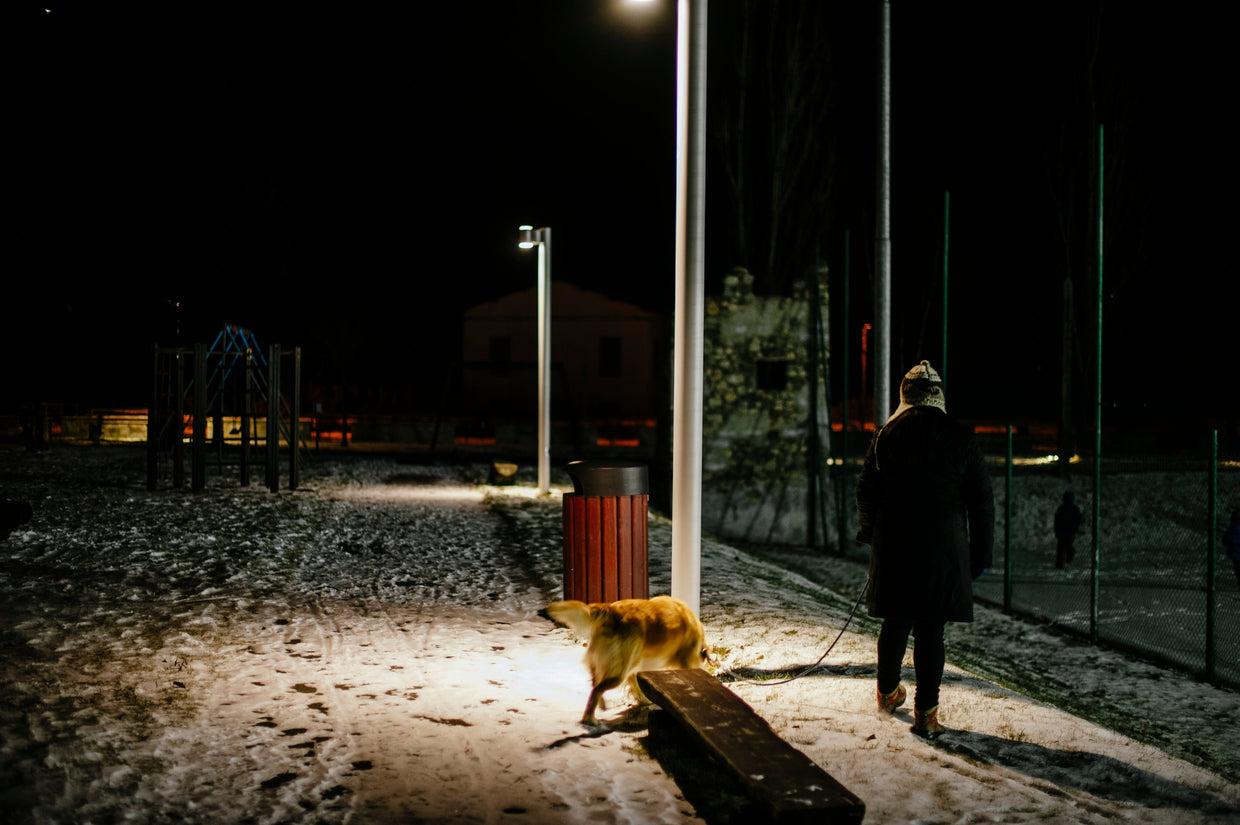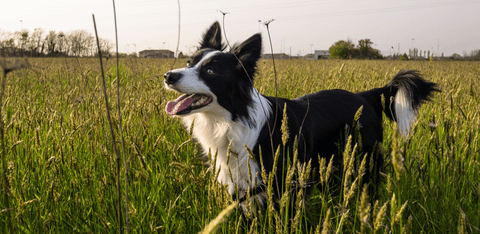

Dog walking in the dark
The days are shorter, the nights are colder and nobody wants to leave their cosy, warm homes. But remember, your dog still needs regular exercise even if it’s dark and chilly. They’ve probably become accustomed to lots of exercise over the warm and bright summer months, and a lack of exercise during winter can lead to behavioural problems and boredom – for you and your dog!
Having said that, some extra precautions should be taken during autumn and winter walkies. This way, you can both enjoy a safe walk even when it’s dark outside. So, what are you waiting for? Get reading…
Walking your dog at night
Navigating the darkness with your dog can be a daunting and difficult experience. Especially if you’re a new dog owner. Although it’s not the same as a summer evening stroll, dog walking in the dark doesn’t have to be scary. Here’s a few of our best tips…
Keep your dog on a lead

Even if you’re in an area where there’s no traffic, and even if your dog has great recall, it’s best to keep them close to you. Just like us, dogs can easily be startled by other people, animals or loud noises. This may cause them to panic, run off and get lost in the dark.
Attaching a bell to your dog’s collar can help you keep track of them. It can also alert other walkers or cyclists before they see you. Alternatively, you can opt for a GPS tracker – like this one from Tractive. Make sure your dog is comfortable wearing a bell or a tracker though, and only use one if your dog is happy to do so.
Our top tip: If you do decide to let your pooch off the lead, make sure you’re in a well-lit area, or somewhere your dog’s familiar with. This way, they’re less likely to get lost.
Stay safe when walking in the dark
- Walk a familiar route. We recommend never trying out a new route when it’s dark. New walking locations should be saved only for daylight hours.
- Always take your phone with you. It comes in handy in case of emergencies. Plus, it double up as a torch and a map!
- Avoid listening to music. And don’t be too preoccupied by your phone. This way, you can stay alert to anything that might distract you or your dog.
- Walk with someone else – like a partner, friend or even a neighbour. If your friend is also bringing a dog, try to make sure the two pooches get along.
- Let someone know when and where you’re going. Let them know how long you expect to be as well.
Our top tip: If you’re alone – or just find it scary walking your dog in the dark – why not try a service like Strut Safe? Give them a call and someone in the Strut Safe team will stay on the phone with you until you’re back safely in your home. Or, take a leaf out of their book and phone a friend while you walk!
Stay well lit

There are plenty of things you can do to help fight the dark, but here’s just a few of our favourites:
- Wear something flashy – literally. This goes for you and your dog. We’d suggest a high-vis vest or something reflective for you, and a flashing collar or lead for your pup.
- Take a torch with you. You might have one on your phone already, or you can invest in a high-quality one with a better range. A head torch is also a great option, as it keeps your hands free.
- Opt for a morning walk if you can. It’s often lighter which means you can go for a longer walk. This way, your evening walk can just be a quick one.
Our top tip: For ulti-mutt safety, give your dog something flashy to wear. Not all dogs like wearing jackets though, so make sure your find a solution that your pet likes, too!
Dress for the occasion
The dress code for an autumn or winter walk in the dark should always be warm and visible.
For you:
- Layer-up and always wear a warm coat if it’s cold out
- Wear sensible and appropriate footwear – flip-flops and sandals should probably be saved exclusively for summer
- Wrap your dog up for the colder weather. Smaller breeds and senior dogs are more likely need a little extra warmth when walking early in the morning or late at night.
Our top tip: If you find that your dog’s extra chilly after their evening walk, make sure you warm them up when you’re back at home. This means lots of blankets and toasty hugs. Read more cold-weather walking tips here.

Other ways to exercise your dog
Get some local tips
There might be some dog exercise classes in the evening, or there may even be a local dog-walking group. Your nearest pet shop or the vets will likely know, so ask around. Dog walkers are another effective, although expensive, way to give your dog the exercise it needs.
Make up for it at the weekend
If you feel like your weekday walks aren’t enough, go all out at the weekend. Research some long walks in your area – like at the park, woods or the beach. You could also take a ball or toy with you to give your pooch a little workout.
True or false? Dogs can see in the dark

True. Sort of. Have you ever noticed that your dog seems more alert in the dark than you are? Your dog’s stronger sense of smell isn’t the only thing at play here. Dogs can see better in the dark than us. Although this isn’t true for all dogs. Check out our guide on how to exercise your dog if they suffer from sight impairment.
We’re not saying that they have owl-like eyesight. They can’t see in complete darkness. But the structure of your dog’s eye is completely different from yours (with added benefits like better night-time vision). They differ in the below few ways:
- Your dog’s retinas are made up from light-sensitive rods. As opposed to yours, which are dominated by cones. These rods are extremely light-sensitive, which means they have better night vision than us.
- Your dog has a secret weapon known as the tapetum lucidum. Essentially, this is just a layer of cells within the eye that acts like a mirror and reflects all light that enters it. This magnifies your dog’s vision in the dark. Unfortunately, our eyes don’t have the tapetum.
- Your dog also has a higher flicker fusion rate. Take your TV for example. To our eyes, the TV is showing one continuous scene. But to your dog, the screen is flickering.




